 |
Dewoitine D 5201938 |  |
| FIGHTER | Virtual Aircraft Museum / France / Dewoitine |
 |
When Emile Dewoitine designed a new fighter to meet the French Air Ministry Programme A23, which in its revised form called for a maximum speed of 520km/h, he was inspired to give it the designation D.520. The prototype flew for the first time on 2 October 1938 with Marcel Doret at the controls. Performance was disappointing and so the second prototype had wing radiators replaced with a ventral unit and introduced a sliding cockpit hood. The third prototype replaced the tailskid with a tailwheel. The D.520 had no real rival in France and was ordered in quantity. Main production lines were at the SNCAM Toulouse factories. For the first time in France women joined the workforce and sub-contractors previously outside the aircraft industry were employed. Each aircraft required only half the man-hours needed to build the main French fighter at that time, the MS 406. The first production aircraft flew on 31 October 1939, but many modifications were required. By the time the German Blitzkrieg was launched only 50 D.520s were with front-line units. By 22 June 1940, 220 were in service. They did well in combat, claiming 77 definite victories against only 34 losses. Vichy units included four Groupes de Chasse and two Aeronavale escadrilles in North Africa. Production restarted for a period by Vichy and then resumed under German supervision. The 891st and last aircraft left the factory in August 1944. Vichy D.520s fought in Syria and in North Africa during the Allied landings. Seventy-five went to the Regia Aeronautica and 100 to Bulgaria, where they flew with the 6th Fighter Regiment. Final operations were with the Free French 'Groupe Doret' against German poc kets of resistance in France from November 1944 to May 1945. Post-World War II, a few were converted as D.520 DC two-seat dual-control trainers.
 Powered by a supercharged 678kW Hispano-Suiza 12Y45 engine, the D.520 was armed with an engine-mounted HS-404 20mm cannon and four wing-mounted 7.5mm MAC machine-guns. The wing was a single-spar structure with duralumin skinning. Ailerons were fabric-covered and flaps pneumatically operated. The fuselage was an all-metal monocoque structure and the wide-track undercarriage legs retracted inwards into the wing profile.
|  COMPANY PROFILE | |||||||||||||||||||||||||||||||||||||||||||||||||||||||
 |

|


